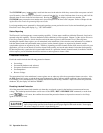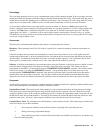
Operation Overview 23
b. One pulse results from each trigger. Therefore, frequency cannot be programmed. The main level, transient level,
and slew rate are programmed as described for continuous operation. The pulse width is programmable from
0.00005 to 4 seconds via the GPIB (TRAN:TWID command). Pulsed transient operation cannot be programmed at
the front panel.
c. The appearance of the pulse at each module’s input may be delayed from the trigger signal. For pulse widths of 17
ms or greater, delay is less than 1.6% of the pulse width. For pulse widths of less than 17 ms, delay is less than 4%
of the pulse width.
In this example, assume that the CC mode is active, the slew rate is at the factory default setting (maximum rate), an external
trigger input is connected to the Electronic Load’s rear panel, and the applicable transient operation parameters have been
set as follows:
HPSL Command Description
TRIG:SOUR EXT Selects the external trigger input.
TRAN:MODE PULS Selects pulsed transient operation.
CURR 5 Sets main current level to 5 amps.
CURR:TLEV 10 Sets transient current level to 10 amps.
TRAN:TWID.001 Sets pulse width to 1 millisecond.
TRAN ON Turns on transient operation.
Figure 2-6 shows the waveform that would result in this pulsed transient operation example. The Electronic Load starts
conduction at the main current level setting (5 amps). When the transient mode is turned on and an external trigger signal is
received, the input level starts increasing at a rate determined by the slew rate. When the value specified by the transient
level setting (10 amps) is reached, it stays there for the remainder of the time determined by the pulse width setting (1
millisecond). After this time has elapsed, the input level decreases to the main level again at the rate specified by the slew
setting and remains there until another trigger is received. Any triggers that occur during the time the transient level is in
effect will be ignored.
Figure 2-6. Pulsed Transient Operation
Toggled Transient Operation
Toggled transient operation causes the module input to alternate between two predefined levels as in continuous operation
except that the transient points are controlled by explicit triggers instead of the internal transient generator. As in pulsed
transient operation, the trigger signal can be an external trigger signal, the GPIB GET function, the *TRG command, the
TRIG command, or the ac line or internal timer signals. Note that toggled transient operation can only be programmed via
the GPIB (TRAN:TOGG command); it cannot be programmed at the front panel.
In this example, assume that the CC mode is active, the slew rate is at the factory default setting (maximum rate), an external
trigger input signal is connected to the Electronic Load’s rear panel, and the applicable transient operation parameters have
been set as follows:


















